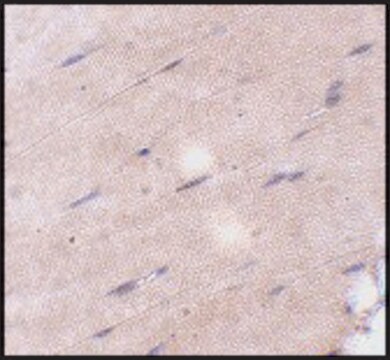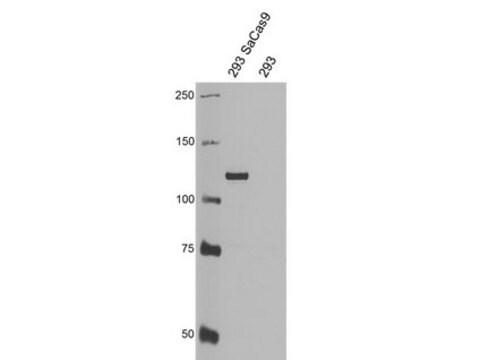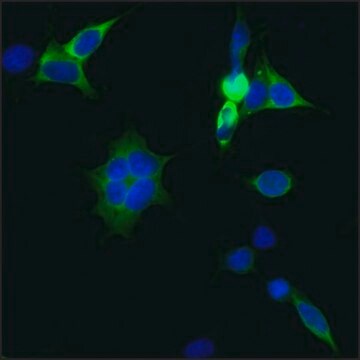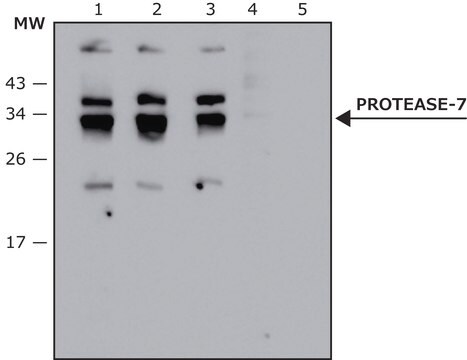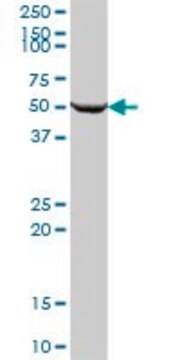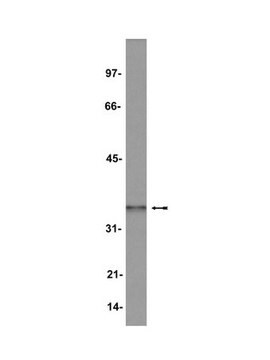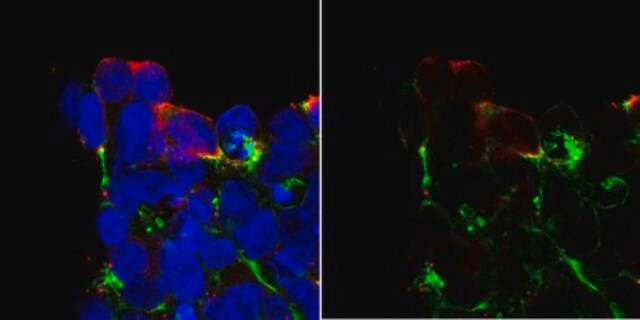SAB4200756
Anti-AsCas12a (Cpf1) antibody, Mouse monoclonal
clone AsCpf-11, purified from hybridoma cell culture
Synonym(e):
Anti-AsCpf1 antibody, Mouse monoclonal, Anti-CRISPR-associated endonuclease AsCas12a from Acidaminococcus sp. (strain BV3L6)
About This Item
Empfohlene Produkte
Biologische Quelle
mouse
Qualitätsniveau
Antikörperform
purified from hybridoma cell culture
Antikörper-Produkttyp
primary antibodies
Klon
AsCpf-11, monoclonal
Form
buffered aqueous solution
Mol-Gew.
~135 kDa
Konzentration
~1.0 mg/mL
Methode(n)
immunoblotting: 1.25-2.5 μg/mL using purified recombinant AsCpf1 produced in E. coli
immunofluorescence: 1.25-2.5 μg/mL using human HEK-293T cells over-expressing AsCpf1 protein
immunoprecipitation (IP): 2.5-5 μg/test using lysate of human HEK-293T cells over-expressing AsCpf1 protein
Isotyp
IgG2a
UniProt-Hinterlegungsnummer
Versandbedingung
dry ice
Lagertemp.
−20°C
Posttranslationale Modifikation Target
unmodified
Allgemeine Beschreibung
Cpf1 (CRISPR from Prevotella and Francisella 1) belongs to Class-2 type V CRISPR-Cas endonuclease system.4-5 Cpf1 comprise several differences from Cas9 protein including cleavage with 5′overhangs, a shorter guide RNA and a longer distance between the seed sequence and the cleavage site.
AsCpf1, Cpf1 from Acidaminococcus sp. (strain BV3L6), was examined together with 15 members of Cpf1 nuclease family and shown to mediate efficient genome editing in HEK293FT cells with an improved results compared to SpCas9.5 AsCpf1 crystal structure in a complex with crRNA and partially duplexed target DNA, shows that AsCpf1 acts as a monomer thus identifying a unique mechanism employed by AsCpf1 for target recognition.
Immunogen
Anwendung
- immunoblotting (~135 kDa),
- immunofluorescence
- immunoprecipitation
Monoclonal anti-AsCpf1 antibody can provide a useful tool for genome editing research such as detecting and monitoring AsCpf1 positively transfected cells.
Physikalische Form
Lagerung und Haltbarkeit
Sonstige Hinweise
In order to obtain best results in different techniques and preparations we recommend determining optimal working concentration by titration test.
Sie haben nicht das passende Produkt gefunden?
Probieren Sie unser Produkt-Auswahlhilfe. aus.
Lagerklassenschlüssel
10 - Combustible liquids
Flammpunkt (°F)
Not applicable
Flammpunkt (°C)
Not applicable
Analysenzertifikate (COA)
Suchen Sie nach Analysenzertifikate (COA), indem Sie die Lot-/Chargennummer des Produkts eingeben. Lot- und Chargennummern sind auf dem Produktetikett hinter den Wörtern ‘Lot’ oder ‘Batch’ (Lot oder Charge) zu finden.
Besitzen Sie dieses Produkt bereits?
In der Dokumentenbibliothek finden Sie die Dokumentation zu den Produkten, die Sie kürzlich erworben haben.
Unser Team von Wissenschaftlern verfügt über Erfahrung in allen Forschungsbereichen einschließlich Life Science, Materialwissenschaften, chemischer Synthese, Chromatographie, Analytik und vielen mehr..
Setzen Sie sich mit dem technischen Dienst in Verbindung.